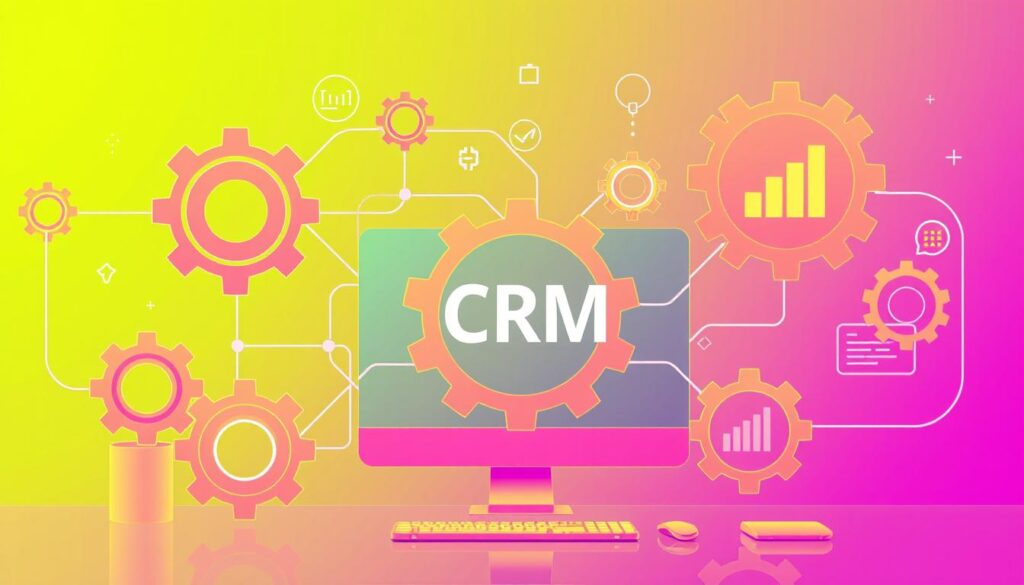In today’s digital world, having streamlined sales processes and increased productivity is essential. This is where virtual sales process automation steps in. It’s changing how organizations handle their digital sales strategies.
Virtual sales automation takes over boring tasks like data handling and scheduling. For example, Swisslog Healthcare saw lead times drop by half after using sales automation software. They also saved 30% on data entry work. This shows how automation boosts efficiency.
Automation is proving itself. Athabasca University saw lead numbers grow by 75% using HubSpot CRM. Similarly, Amazon makes 35% of their revenue from smart cross-selling and upselling. This highlights how technology can dramatically improve sales.
Also, sales reps using mobile CRM software hit 65% of their sales targets. Those without it only reach 22%. This shows that technology use is closely linked to sales success. Thus, virtual sales process automation is a key part of a successful digital sales plan.
Key Takeaways
- Automating sales processes significantly increases sales reps’ active selling time.
- It’s crucial to invest in CRM software for better customer management and process streamlining.
- Using CRM effectively boosts efficiency, sales results, and maintains customer engagement.
- Automation greatly benefits key account management and customer retention.
- It prepares businesses for future trends and keeps them competitive.
- Generative AI and analytics are essential for personalizing customer experiences and boosting productivity.
Understanding Virtual Sales Process Automation
In an era where efficiency and speed are paramount, automation in sales is transforming business strategies. It uses advanced technology to make operations smoother, which boosts performance and efficiency. By adding automated sales tools, tasks become simpler, and sales teams can focus on selling rather than on administrative tasks.
What is Virtual Sales Process Automation?
It’s a technology that automates key parts of the sales process, from finding leads to closing deals. This reduces manual work and mistakes, making the sales cycle more efficient and effective. It aims to increase the time spent with clients and prospects by reducing time on non-revenue tasks.
Key Components of Automation
Automation in sales is driven by CRM integrations, real-time analytics, and AI-driven chatbots. These elements work together to automate tasks like data entry, managing customer records, and qualifying leads. They change slow paper tasks to faster digital ones.
Benefits of Automating Sales Processes
Shifting to automated tools brings many benefits, like better efficiency and happier sales teams. Below is a table showing statistics that highlight the transformation through automation:
| Impact Area | Statistic | Outcome Description |
|---|---|---|
| Time Spent on Selling | 28% of time | Sales teams focus primarily on administrative tasks; automation reallocates focus to active selling. |
| Profit Increase Potential | 38% profit gain | Reduction in non-revenue activities directly correlates with higher profitability. |
| Productivity Boost | Tasks reduced from days to hours | Automation accelerates sales cycles, enabling tasks completion more efficiently. |
| Employee Satisfaction | 89% increased satisfaction | Introduction of virtual selling strategies heightens workplace morale and retention. |
| Lead Scoring Efficiency | Automated rapid processing | Automated lead scoring identifies valuable prospects faster, enhancing engagement opportunities. |
Automation tools not only reduce the workload for sales teams but also create an environment where they use their skills efficiently in closing leads. Thus, automation isn’t just helping but transforming sales strategies fundamentally.
The Importance of Streamlining Sales Processes
Today’s markets move fast, pushing sales teams to do more and perform better. Traditional sales methods are often slow, filled with manual tasks. Streamlining the sales process is crucial for staying ahead. It’s a must for being competitive in the current market.

Challenges in Traditional Sales Methods
Sales staff in traditional setups are overwhelmed with data entry and managing many spreadsheets. They manually track customer talks too. These tasks take lots of time and are prone to mistakes. So, they have less time for building relationships and sealing deals.
The real issue is that connecting with clients takes a backseat to other work. This situation hurts sales results and worker happiness significantly.
How Automation Addresses These Challenges
Virtual selling strategies and automation tech help solve these problems. Tools like Salesforce, HubSpot, and Zoho CRM allow businesses to automate boring tasks. With automation, teams can focus more on talking to clients and planning strategies. It makes the whole digital sales process optimization better.
| Benefits of Automation | Percentage Improvement |
|---|---|
| Productivity Increase | Up to 20% |
| Time Saved on Data Entry | 30% |
| Reduction in Lead Time | 50% |
| Improvement in Customer Engagement | Significant |
| Error Reduction in Data Handling | High |
Integrating automation improves sales team efficiency and helps hit or exceed sales goals. It uses tools for automated follow-ups, scoring leads, and onboarding customers. This not only makes operations smoother but also boosts customer experience. Effective sales process optimization leads to a great return on investment, happier customers, and a strong competitive position.
Key Tools for Virtual Sales Process Automation
The digital sales process is changing fast, thanks to new tools like sales automation software, CRM integration, and AI-powered chatbots. These aren’t just nice to have. They’re needed to make work easier, help customers better, and sell more.
Popular Software Solutions
Some platforms are top picks because they do a lot and work well with other tools. HubSpot Sales Hub is great for automated emails and sales data. It helps keep track of clients and how well you’re doing. Clearbit and 6sense are awesome for understanding customers and finding the ones most likely to buy.
Features to Look for in Automation Tools
Choosing the best automation tools means knowing what your sales team needs. Tools like Clari score leads with AI, and Cognism keeps data fresh. These features help make smart decisions and plan strategies.
- Multi-channel communication for seamless client interactions
- Advanced analytics for generating actionable insights
- Customizable AI chatbots for 24/7 customer service
Automation isn’t only about saving time. It improves how you talk to customers and makes your business run smoother. Take Athabasca University, for example. By using HubSpot’s CRM, they got 75% more leads in three years. This shows how powerful these tools can be.
| Tool | Primary Feature | Impact |
|---|---|---|
| HubSpot Sales Hub | Email Automation, Sales Analytics | Improved lead management and performance tracking |
| Clearbit | Lead Scoring, Buyer Intent | Enhanced targeting and customer insights |
| Clari | AI-Powered Sales Forecasting | Accurate revenue predictions and deal management |
| Cognism | Data Enrichment, Lead Generation | Streamlined prospecting and increased lead quality |
Using automated sales tools cuts down on routine tasks. This lets the sales team focus on selling. Plus, it makes for happier customers with faster service and more relevant talk.
Smart decisions based on data are the way to go in sales these days. The right tools can not just meet but predict market demands. They improve communication with AI chatbots and help prioritize leads with analytics. This leads to big wins for businesses.
Integrating Automation into Your Existing Sales Strategy
Businesses today are focusing on boosting sales operations while increasing productivity. They do this by adding automation to their sales strategies. It’s about looking at how things are currently done, and then bringing in tech tools to help. Tools like CRM software make the sales process much better.
Steps to Implement Automation
Adding automation starts by checking your current methods to spot chances for automation. After this, you must pick the best tools that fit with your CRM system and make sales smoother. It’s key to add these tools carefully. They should fit well with what you already use and grow with your business.
- Assessment of current sales operations: Find tasks that take too much time or are done over and over.
- Selection of automation tools: Pick solutions that work with your existing CRM and help you reach your goals.
- Strategic implementation: Add automation tools step by step to cut down on problems and make things easier.

Measuring Success After Implementation
After you add automation, it’s important to see how well it’s working. You should look at how sales productivity, lead conversions, and customer happiness have changed. This tells you what needs tweaking.
| Metric | Pre-Implementation | Post-Implementation |
|---|---|---|
| Sales Productivity | – | Improved by streamlined collaboration |
| Lead Conversion Rate | – | Increased due to personalized email sequences |
| Customer Satisfaction | – | Enhanced through timely interactions |
| Revenue Growth | – | 10% increase within 6-9 months |
Adding tech solutions for sales does more than just cut down on boring tasks. It also lets sales teams spend more time with clients and close more deals. With CRM tools, teams keep all their info in one place. This makes talking to each other and following a data-driven approach better, improving how sales work.
Enhancing Customer Experience with Automation
Automation is changing the way brands interact with their customers. It’s not just about being more efficient. With automated follow-ups and smart lead nurturing, businesses can reach new heights in sales process efficiency and improved customer engagement.
Personalization through Automation
At the heart of personalization is automation. It lets companies analyze customer behavior and tailor their approach. This means products and services can be recommended in a way that feels personal, boosting chances of additional sales.
Automated Follow-Ups and Lead Nurturing
Automated systems make sure no customer interaction goes unnoticed. They keep communication lines open and help move leads through the sales funnel. With tools like email sequences and AI chatbots, these systems create a responsive and engaging dialogue with potential customers.
Consumer expectations are evolving. A large number of customers now prefer personalized interactions to generic ads. Interestingly, 86% of customers would pay more for better service, showing the value of automation in personalization.
Automation makes customer journeys more exciting and efficient. Tools like AI chatbots and automated emails give companies valuable feedback. This information helps improve services and communication.
In embracing automation, brands are not only making their operations smoother. They’re significantly enhancing the customer experience. This leads to better satisfaction and loyalty, which is crucial in the competitive business world.
Training Your Sales Team for Automation Success
Adding virtual sales process automation is a big change. It’s not just about new tools. It changes how the team works and understands their tasks. For companies wanting to use virtual selling strategies, teaching salespeople to use new tools is as important as the tools.
Importance of Employee Buy-In
Introducing productivity with automation tools can face pushback if the team doesn’t see its value. It’s essential to show how automation cuts down on routine work. For example, salespeople often spend around 67% of their time on tasks not related to sales. Automation can reduce this, giving them more time for selling.
Providing Effective Training Resources
The path to successful virtual sales process automation includes proper education and ongoing support. Training must be detailed and specific. It should cover things like how to use the CRM, manage data, track leads, and handle automated messaging.
Training must include simulations on automated lead scoring and nurturing. It should also show how to create personalized messages with automation tools. For instance, using LeadFuze for finding leads can save time and improve the quality of initial contact.
Offering regular training sessions, examples of real-life uses, and strong support boosts a sales rep’s confidence and skill in using automation. Leaders should reward the adoption and skillful use of digital tools by the sales team. This highlights how important these tools are in meeting sales goals and boosting productivity.
Overcoming Common Automation Challenges
Automation is key for businesses to improve their work and customer care. Yet, moving to these systems can be hard. Issues include automation problems, keeping sales data safe, and securing the systems.
Addressing Resistance to Change
One big barrier is the fear of new tech inside a company. It’s important to explain the perks of digital sales process optimization well. Pairing new employees with experts can help. This makes accepting new tech easier, leading to a better switch to automation.
Ensuring Data Privacy and Security
Digital tools play a big part in sales, making data safety crucial. Sales teams need the right info and tools to keep sales data private and secure automation. Being open about security steps and ongoing training is key. This keeps trust and operations running smoothly.
Companies facing these challenges have seen big benefits. For example, automation improved data accuracy by 90% and team productivity by 30%.
| Metrics | Improvement Due to Automation |
|---|---|
| Data Accuracy | 90% Improvement |
| Response Time to Leads | 5x Faster |
| Team Productivity | 30% Increase |
| Administrative Task Time Reduction | 50% Reduction |
Future Trends in Virtual Sales Process Automation
The sales world is quickly moving towards new strategies. This change is boosted by machine learning in sales and AI tools. Salesforce notes that 69% of sales experts see automation as key for close customer relationships. McKinsey also says that by 2025, 30% of B2B sales tasks might be automated. This could greatly improve efficiency and productivity in sales.
AI and Machine Learning in Sales Automation
AI is becoming a main player in sales automation. Sales teams hit their goals easier with AI, through better workflows and analysis. It’s not just about doing tasks faster. AI helps make better decisions by processing data in real-time. Gartner points out that 80% of B2B sales will be digital by 2025. Businesses use AI to predict trends and understand customer needs better, shaping future sales plans for great results.
The Role of Virtual Reality in Sales Experiences
Virtual reality (VR) has unlimited potential in sales. ITSMA has found that personalized marketing, like Account-Based Marketing (ABM), gives great returns. Adding augmented reality (AR) and VR takes customer engagement to new levels. AI and VR together are changing how we experience sales, by making product demos immersive. According to Gartner, by 2025, customers will use self-service platforms more, making the digital buying experience richer and more autonomous.
FAQ
What is Virtual Sales Process Automation?
Virtual sales process automation uses tech for routine tasks in sales. This includes data entry, scheduling, and managing leads. It helps increase productivity and efficiency. It also boosts digital sales strategies by focusing sales teams on important tasks such as building relationships and closing deals.
What are the Key Components of Automation in Sales?
Key parts are CRM integration, AI-powered chatbots, automated follow-ups, and real-time analytics. They work together to smooth out the sales process.
What are the Benefits of Automating Sales Processes?
Benefits are better efficiency and fewer errors in the sales process. It leads to better lead conversion rates and customer interactions. Automation also makes the customer experience more personal. It lets sales teams focus on selling strategies and managing customer relationships better.
What Challenges are Present in Traditional Sales Methods?
Traditional methods often mean sales reps spend too much time on admin tasks. This reduces their time for selling and building client connections. Such inefficiency can lower productivity and slow the sales process.
How Does Automation Address These Sales Challenges?
Automation takes over the manual tasks. This lets sales reps concentrate on talking to prospects and closing deals. As a result, the sales process gets optimized and streamlined.
What are Popular Software Solutions for Sales Process Automation?
Popular solutions are CRM systems like HubSpot CRM for customer interactions, AI chatbots for service, and email tools like Mailchimp. These can personalize communication with prospects and customers.
What Features Should You Look for in Automation Tools?
Features to look for include easy integrations, analytics, customizable templates, AI features, and scalability. These features ensure your automation software is versatile and impactful.
What are the Steps to Implement Automation in Sales?
Steps include evaluating your sales processes and choosing tools that meet your goals. Integrate these tools with your current systems and train your team on them. Then, use metrics and analysis to measure success.
How Can You Measure Success After Implementing Automation?
Measure success by improvements in metrics like response times, lead conversion rates, and sales productivity. Tracking these metrics helps in optimizing sales operations.
How does Personalization Enhance Customer Experience in Automation?
Personalization in automation means more targeted and relevant talks with prospects. This improves engagement and makes each sales touchpoint more effective and tailored.
What Role do Automated Follow-Ups and Lead Nurturing Play?
Automated follow-ups and nurturing ensure regular and timely engagement with prospects. This helps guide them through the sales journey towards a successful sale.
Why is Employee Buy-In Important for Automation Success?
Employee buy-in is crucial for maximizing automation’s benefits. It ensures the sales team uses the new tools effectively. Without their support, gains in productivity are at risk.
What Kind of Training Resources are Effective for Sales Automation?
Effective resources include detailed guides, hands-on workshops, and ongoing support. These help the sales team become skilled at using the new tools. They learn how to boost sales with automation.
How Do You Address Resistance to Change in Automation?
To address resistance, clearly share the benefits of automation. Involve the team in the change process and answer their concerns openly. Support from leaders and training are key for acceptance.
How Can You Ensure Data Privacy and Security in Sales Automation?
Keep data safe and private by using strong security measures, updating systems regularly, doing privacy assessments, and training staff on data security.
What is the Role of AI and Machine Learning in Sales Automation?
AI and machine learning bring advanced analysis and personalized customer experiences. They help sales reps make informed decisions and refine selling strategies.
How Might Virtual Reality Impact Sales Experiences in the Future?
Virtual reality could change sales by offering immersive product demos and interactions. This opens new ways for engagement and sharing stories in sales.



